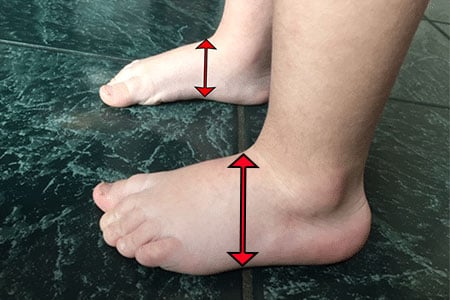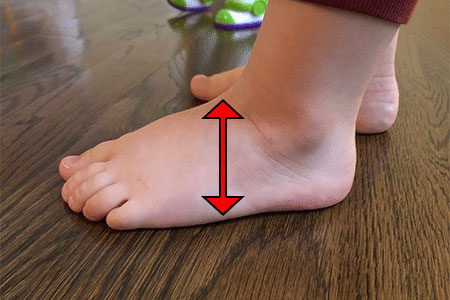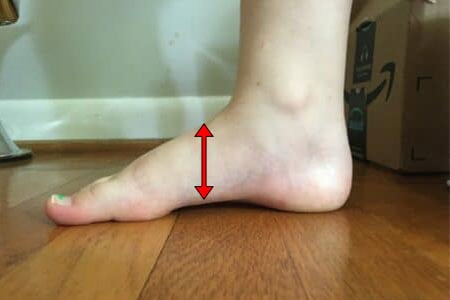High Instep VS High Arch – The Best Kids’ Shoes for Either of These Conditions!

Most parents get confused about what is the difference between having a high arch versus having a high instep. While most children with high arches tend to have a high instep, children with high insteps don’t necessarily need to have a high arch. In fact, I have seen flat-footed children with high insteps. It’s important to understand the difference between having high insteps versus having high arches to figure out what shoes will work best for your child’s feet.
Children with high arches or high insteps tend to have the hardest time finding shoes, and they are usually very limited in the type of footwear they can wear.
What is a High Instep?
A high instep occurs when the top part of the foot is higher than average. This can make it challenging to find shoes that fit comfortably, as the increased height can cause tightness across the top of the shoe. A high instep often requires shoes with more depth and adjustable features.

What is a High Arch?
A high arch, or cavus foot, is characterized by an exaggerated curve on the bottom of the foot. This means that when standing, most of the body weight is supported by the heel and ball of the foot, rather than being evenly distributed. High arches can lead to stability issues and may require shoes with additional cushioning and support.

How to Figure Out If Your Child Has a High Instep or a High Arch?
Understanding whether a child has a high instep or a high arch is critical because it influences the type of footwear needed.
High Arch Vs High Instep Example

If you think your child has a high arch, I recommend using this virtual foot assessment to confirm it.
High Instep Vs High Arch Example

If you believe your child has a high instep, I suggest that you use this virtual resource to confirm it.
Why It’s Important to Tell the Difference
Children with high arches are more likely to develop foot and leg pain since their feet are not able to absorb shock, especially if they are involved in sports or high-impact activities. I usually recommend shoes that provide a substantial outsole (extra cushion), to compensate for their lack of natural shock absorption. Having high arches can make your child more susceptible to developing certain foot conditions such as heel pain, ball of the foot pain, or plantar fasciitis.
What Shoes Should Kids with High Insteps or High Arches Wear?
There is one common feature that your kids’ shoes must provide to accommodate the shape of a high arch or a high instep. Most parents make the common mistake of providing their children with longer and wider shoes to accommodate their child’s high instep or high arch, when in reality they should be looking for shoes with extra depth.
Shoes that provide extra depth are extremely effective in accommodating the shape of a child with a high instep or a high arch. They allow the feet to fit deeply inside the shoes, preventing the top part of the feet (instep), from rubbing against the top part of the shoes.

Access a List of Shoes for Kids with High Arches
For children with high arches, focus on shoes that offer exceptional cushioning and support. Proper footwear can significantly enhance comfort and prevent potential foot problems associated with high arches.
Access a List of Shoes for Kids with High Insteps
When selecting shoes for children with a high instep, consider options that provide extra depth and flexibility. The right pair can alleviate pressure points and ensure that your child remains comfortable throughout the day.
My Experience as a Passionate Shoe Fitter
Having worked with families from all over the world, I’ve seen firsthand how the right pair of shoes can make a significant difference in a child’s comfort and foot health. My approach involves understanding each child’s unique foot shape and condition, enabling me to provide personalized shoe recommendations that cater to their specific needs. If you have any questions or need any further assistance, you can also contact me via email and I will get back to you as soon as possible.
Every child’s foot is different, and so are their needs. I have seen several children with normal arches that have high insteps, and I have also even seen flat-footed children with high insteps. This is why you need to be able to tell the difference between having a high arch and having a high instep.


Thank-you so much for this information!
I am happy to help.
I grew up with both a high instep and a high arch long before those terms were anywhere near commonplace. It made shoes a pain. My parents bought longer and wider shoes, as you said, to accommodate. It did me no favors, though the balme is not theirs.
The first time I heard the word “instep” was during my undergrad years. A simple definition and I could tell mine was high.
After much weight loss I did go from wide width to medium, but my instep and arch didn’t change. The arch was obviously high by sight though, without the extra fat.
I leave those foot prints like out of bad pictures that only show heel, ball and toes. I now suffer from stress fractures of the third and fourth metatarsals and a lot of foot pain because of these issues.
I do not know if my years of inappropriate footwear added to that or not, but am thankful that both as an adult and as the years progress I have many more options.
I spent many years in heels or sandals that covered only my toes and heels, leaving my instep and arch exposed as a way of dealing. (I hated the winter as a result.) That did no favours either.
I now have an array of shoes, trainers included, but I will be honest, my arch/instep in high enough that after a number of hours even these high priced trainers have to come off for me to find imprints on the top of my foot. Seems I will be forever looking.
Hello Laura,
Thank you so much for sharing your experiences. I am sorry to hear that you have not been able to find a single pair of sneakers/trainers that work well for your foot shape. Are you writing from the UK? I can try to help you look for the correct types of shoes for your feet, I just need to know the country that you are contacting me from to check what shoes you might be able to try.
Hello! My daughter is 9 and has high arches. She is also a toe walker.
She has been having problems with constant pain in her feet and legs due to those issues. We are working with doctors of course, but I am also wanting to find some better supportive shoes for her as well. At the end of the day she is often limping or trying to walk on the outside of her feet because they hurt so bad.
What info do you need from me to get accurate information?
Hello Sarah,
In order for me to recommend specific shoes for your daughter I first need to know whether her feet are narrow, medium, wide, or extra wide. If you are unsure of your daughter’s exact foot shape I suggest that you follow the instructions here:
How to Measure Your Kids’ Foot – 2 Simple Steps to Determine Foot Length and Foot Width
Have you been told by your medical professionals whether your daughter’s toe walking is due to a neurological or neuromuscular condition?
I also need to know from which country you are contacting me to check what specific shoes are available in your area.
Our one year old grandson has just begun to walk. No baby shoes seem to fit him. His instep is about 13/4 ” and length 5 inches. Where can I find soft shoes that would fit him?
Hello Karen,
If you need to retrieve your grandson’s exact foot length and shape you need to follow the instructions here:
How to Measure Your Kids’ Foot – 2 Simple Steps to Determine Foot Length and Foot Width
As far as soft shoes are concerned, is your grandson learning how to walk or already walking confidently?
Thank you for sharing your knowledge with others. My daughter is nearly impossible to fit for supportive, comfortable and non-sneaker shoes. Do you have a recommendation for a shoe that would work for dressier or a work environment? High instep, size 2.5-3.
Thank you.
Hello June,
I am happy to provide you with specific shoe recommendations but first I need to know whether your daughter’s feet are narrow, medium, wide, or extra wide.